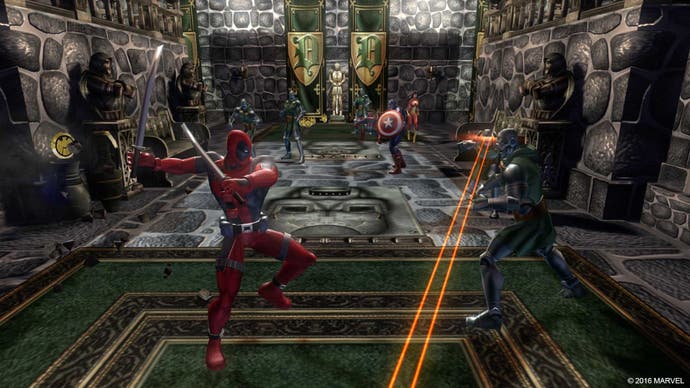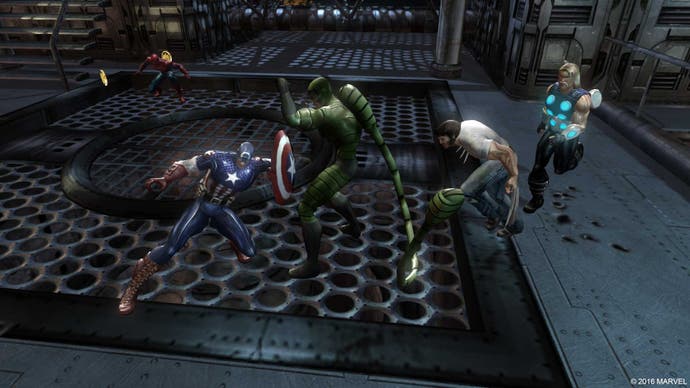Marvel Ultimate Alliance: the last great licensed video game?
We don't need another hero.
Editor's note: To mark the occasion of Marvel Ultimate Alliance's re-release, we tempted Dan Whitehead back from semi-retirement to explore what made the original so special. It's worth noting that the PC port has some issues, and Digital Foundry will be along to assess them in due course.
Licensed video games have a toxic reputation, and often with good reason. Few are any good. Most are downright terrible, their use of existing characters and stories somehow making rote gameplay and uninspired design seem even worse. But when a licensed game works, the result can be an absolute joy, allowing fans to experience and explore a beloved property from a fresh perspective, or simply live out a lifelong fantasy.
Activision's Marvel Ultimate Alliance, first available in 2006 for the PS2 and original Xbox and re-released this week on PC, PS4 and Xbox One, is such a game, and it's one that I would argue represents the last gasp of the classic "video game tie-in" era.
While there have been dozens of games based on the sprawling Marvel Comics universe, Ultimate Alliance was the first to truly treat all those overlapping characters and stories as a single entity. It really dove deep into comic book lore and delivered an epic adventure that featured dozens of characters, both famous and obscure, and took them to every corner of this fictional universe.

In gameplay terms, it's a Diablo-esque action RPG. You steer a squad of four superheroes through a series of mission areas, viewed from an elevated top-down perspective. Mash up the bad guys for XP, mash up the scenery for coins with which to upgrade costumes and powers, and try and tick off as many side missions as you can along the way.
Developer Raven Software already had prior form in this area, having delivered the solidly entertaining 2004 title X-Men Legends and its less effective sequel, Rise of Apocalypse. Ultimate Alliance was a refinement of this template, and revisiting the game in 2016 it's fair to say that some of its rougher edges and outdated mechanics haven't aged particularly well. Games have become so frictionless in recent years, as designers ensure you slide to the end of the game with the minimum of frustration, that it's weird to return to a game where you have to scurry around picking up every spilled coin by hand, rather than having them automatically slurp into your inventory.
Ultimate Alliance isn't really a great game by any stretch of the imagination, but it is a robust and engaging example of its genre, enlivened by a sprinkling of weird ideas and built on a foundation of genuine RPG depth. It's a game where each level up choice matters, where the player who pays attention to their squad, their equipment and their upgrades is at a definite advantage.
What truly impresses - and what still makes me swoon a little - is how clearly in love with the Marvel universe the game is. It's worth remembering that this was the last big Marvel game to launch before the brand began its relentless colonisation of cinema screens and pop culture at large. In 2006, the Iron Man movie was still two years away. Nobody outside of comic fandom knew who Tony Stark was. The idea that Thor could become a blockbuster celebrity, or that Doctor Strange would warrant a film starring some of the world's most acclaimed actors, seemed utterly ludicrous.

Ultimate Alliance showed that games got this stuff before movies did. This is a breathless dash through as many heroes, villains and other comic book touchstones as possible. In the first level alone, as Spider-Man, Captain America, Thor and Wolverine defend a SHIELD helicarrier, you encounter Ultron clones and Doombots. You meet Nick Fury and Black Widow, and battle Scorpion, Bullseye, Radioactive Man and the Winter Soldier.
You fight Fin Fang Foom as the first boss fight, for Kirby's sake! In the second level, you come face to face with the bulbous floating head of MODOK and engage in a trivia contest with him. It took cinema the best part of fifteen years and dozens of films to embrace this level of Silver Age camp with a straight face, but Ultimate Alliance just dives right in there. By the end of the game, you'll have travelled to Atlantis and Asgard, Murderworld and Mephisto's underworld, the Skrull home planet and the Shi'ar space empire. For hardcore fans, it's an all-you-can-eat buffet of everything you ever loved.
That it piles its plate with as many treats as possible would be enough to earn Ultimate Alliance a place in the heart of most comic connoisseurs, but what really impresses is how it takes that attention to detail and bakes it into the game at an even deeper level. As your roster of characters expands, you can have fun by discovering which combinations produce bonus effects. Do you know which heroes stood in for the Fantastic Four or made up the New Avengers line-up? Put them together in a squad and get a stat boost.
Each character also has a variety of costumes, drawn from throughout their careers, to choose from. Again, mix and match these in ways that fit in with comic lore and you're rewarded for it, just as you're rewarded with unique dialogue should you have certain party members with you during each NPC conversation. This is a game that doesn't just know that Wyatt Wingfoot is an interesting character worthy of inclusion, but that his friendship with the Human Torch should be reflected in dialogue that many players will never even see.

The developers at Raven could easily have not bothered with a detail like that - and hundreds of others like it - but they did, and it matters. Ultimate Alliance is so clearly the product of people confident in their abilities and thrilled at the chance to play with every toy in the box. Even if you don't pick up on every reference, every hint at deeper relationships first established in back issues from the 1970s, it still comes across. There's a kind of creative osmosis where that level of deep connective tissue has a detectable positive impact on the upper strata of gameplay, regardless of whether or not you know that Black Panther and Storm were married once upon a time.
And that's what is too often missed in licensed games. Produced to rushed deadlines, subject to stifling approvals from too many bean counters, tie-ins are vulnerable to becoming bland, shallow efforts, shovelled out of the door as quickly as possible in the hope that the logo on the box will do all the hard work.
The Lego games have inherited Ultimate Alliance's giddy geeky thrill, but apart from that notable exception it seems that the licensed video game has almost completely vacated the console market, aiming instead for the mobile audience where a free download and a marketable brand can more easily deliver the required number of users. Few will be sad to see such an unloved genre disappear, but Ultimate Alliance's revival has reminded me, at least, of what's possible when popular IP, ripe with potential, ends up in the hands of passionate developers.











